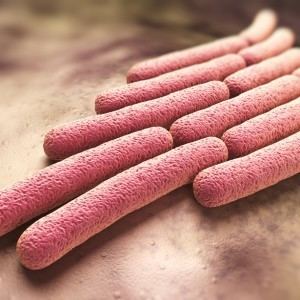Order Enterobacteriales | Phylum Proteobacteria Scientific name Shigella flexneri Rank Species | |
 | ||
Similar Shigella sonnei, Bacteria, Shigella boydii, Yersinia enterocolitica, Salmonella enterica subsp en | ||
Shigella flexneri
Shigella flexneri is a species of Gram-negative bacteria in the genus Shigella that can cause diarrhea in humans. Several different serogroups of Shigella are described; S. flexneri belongs to group B. S. flexneri infections can usually be treated with antibiotics, although some strains have become resistant. Less severe cases are not usually treated because they become more resistant in the future.
Contents
Shigella flexneri
Discovery
The species was named after the American physician Simon Flexner; the genus is named for Japanese physician Kiyoshi Shiga, who researched the cause of dysentery.
Infectious cycle
S. flexneri contains a virulence plasmid that codes for three virulence factors: a type-3 secretion system (T3SS), invasion plasmid antigen proteins (ipa proteins), and IcsA (used for cell-to-cell spread).
Upon infection, S. flexneri injects the host cell cytoplasm with ipa proteins using the T3SS—a needle-and-syringe-like apparatus common to many Gram-negative pathogens. These ipa proteins induce "membrane ruffling" by the host cell. Membrane ruffling creates membrane pockets which capture and engulf the bacteria. Once inside, S. flexneri uses host cell actin for propulsion to move directly from cell to cell using a cellular mechanism known as paracytophagy, similarly to the bacterial pathogen Listeria monocytogenes.
S. flexneri is able to inhibit the acute inflammatory response in the initial stage of infection by using an effector protein, OspI, which is encoded by ORF169b on the Shigella large plasmid and secreted by the type III secretion system. It dampens the inflammatory response during bacterial invasion by suppressing the TNF-α-receptor-associated factor 6 (TRAF6)-mediated signalling pathway. OspI has glutamine deamidase activity, and is able to selectively deaminate glutamine at position 100 in UBC13 to glutamate, and this results in a failure of the E2 ubiquitin-conjugating activity which is required for TRAF6 activation.
Small RNA
Bacterial small RNAs play important roles in many cellular processes. RnaG and RyhB sRNAs have been well studied in S. flexneri. Ssr1 sRNA, which could play role in resistance to acidic stress and regulation of virulence was shown to exists only in Shigella.
